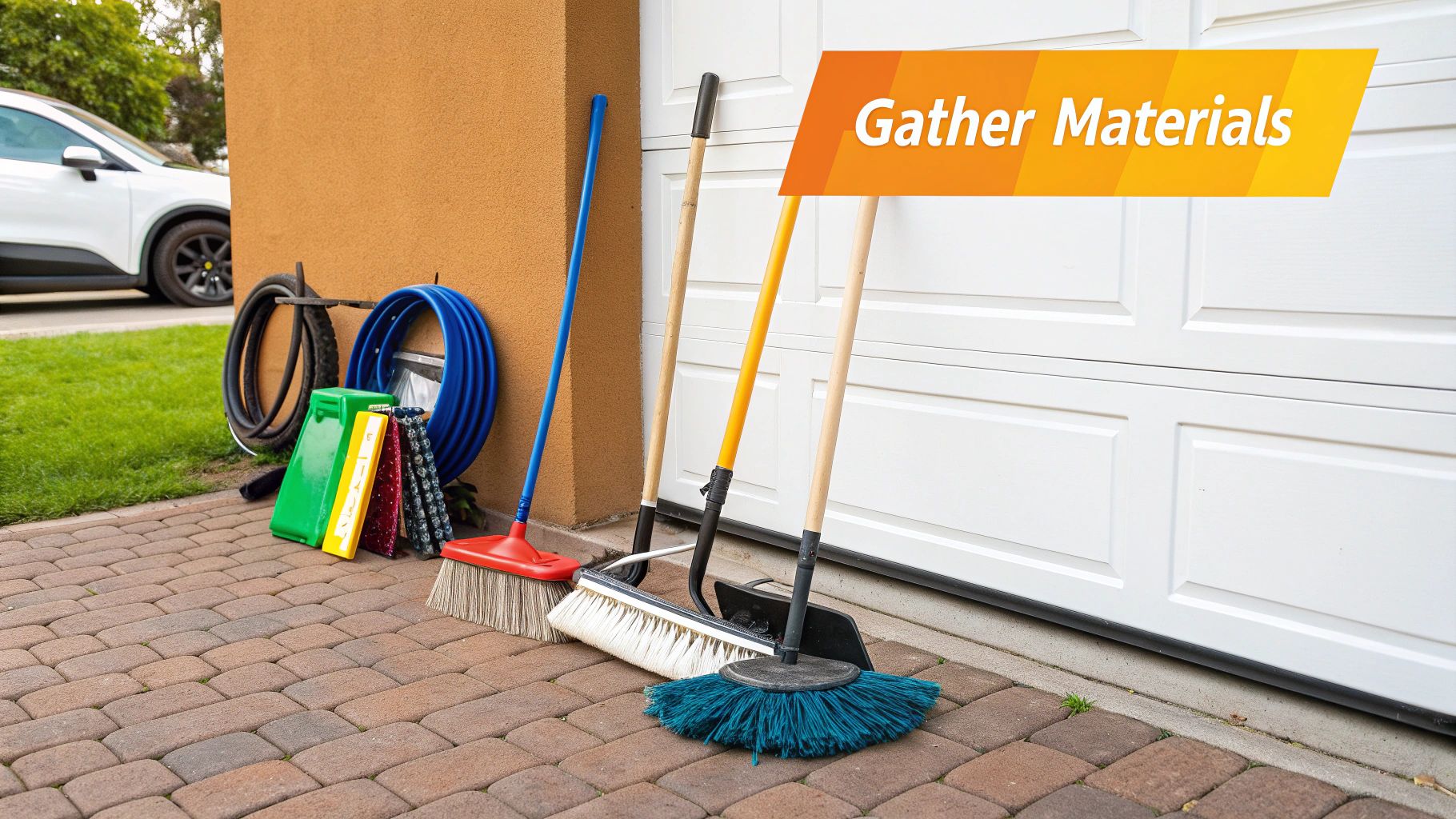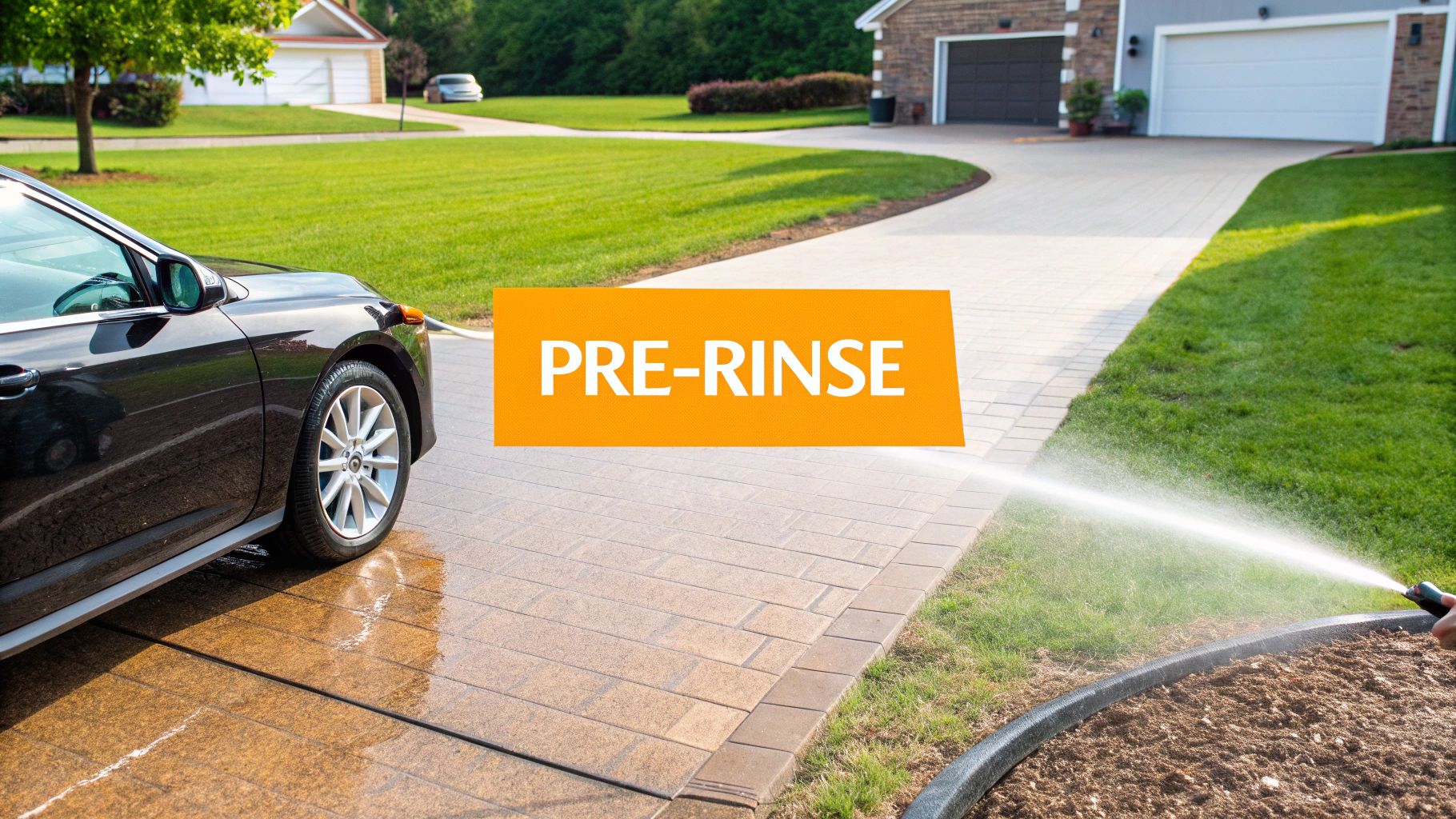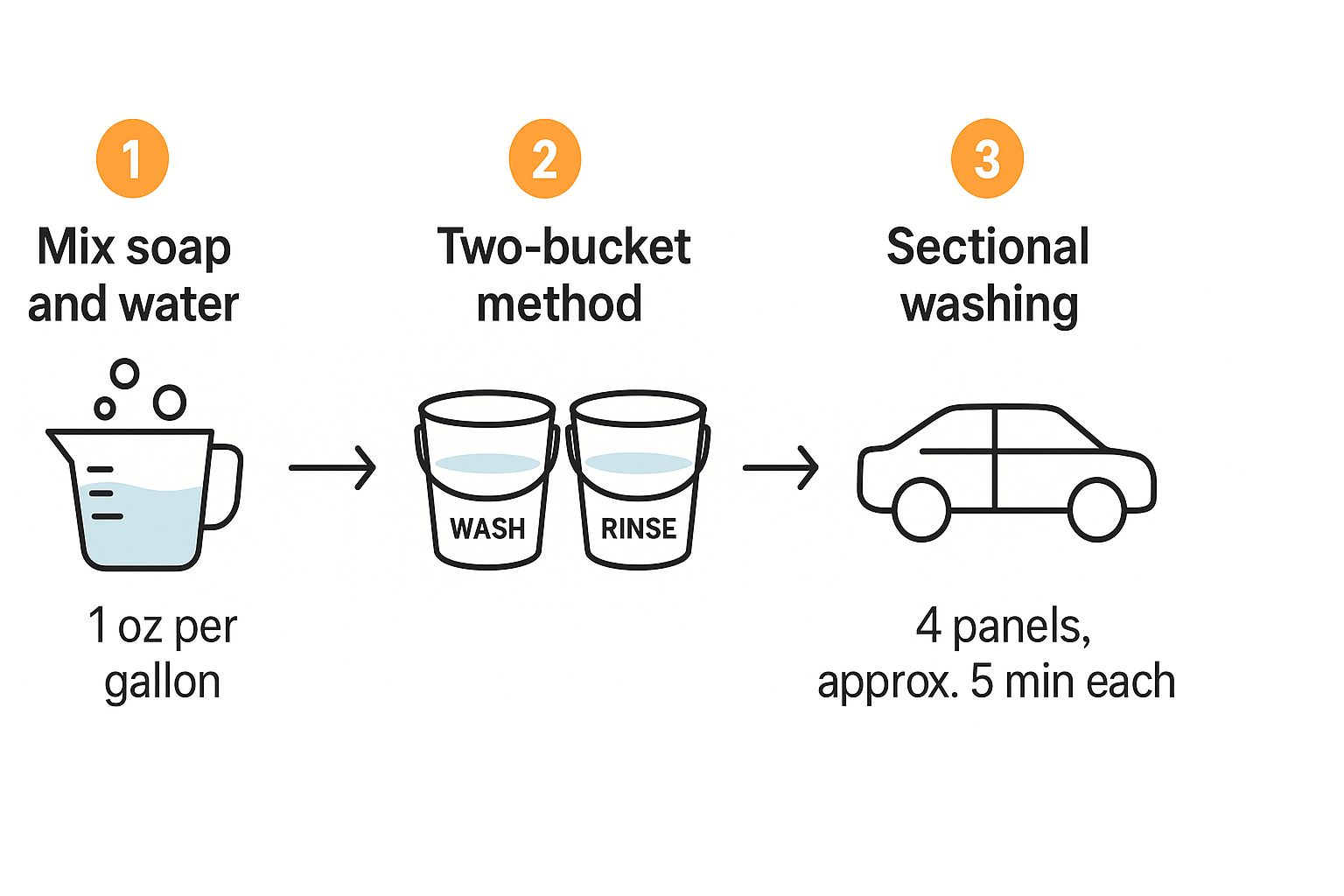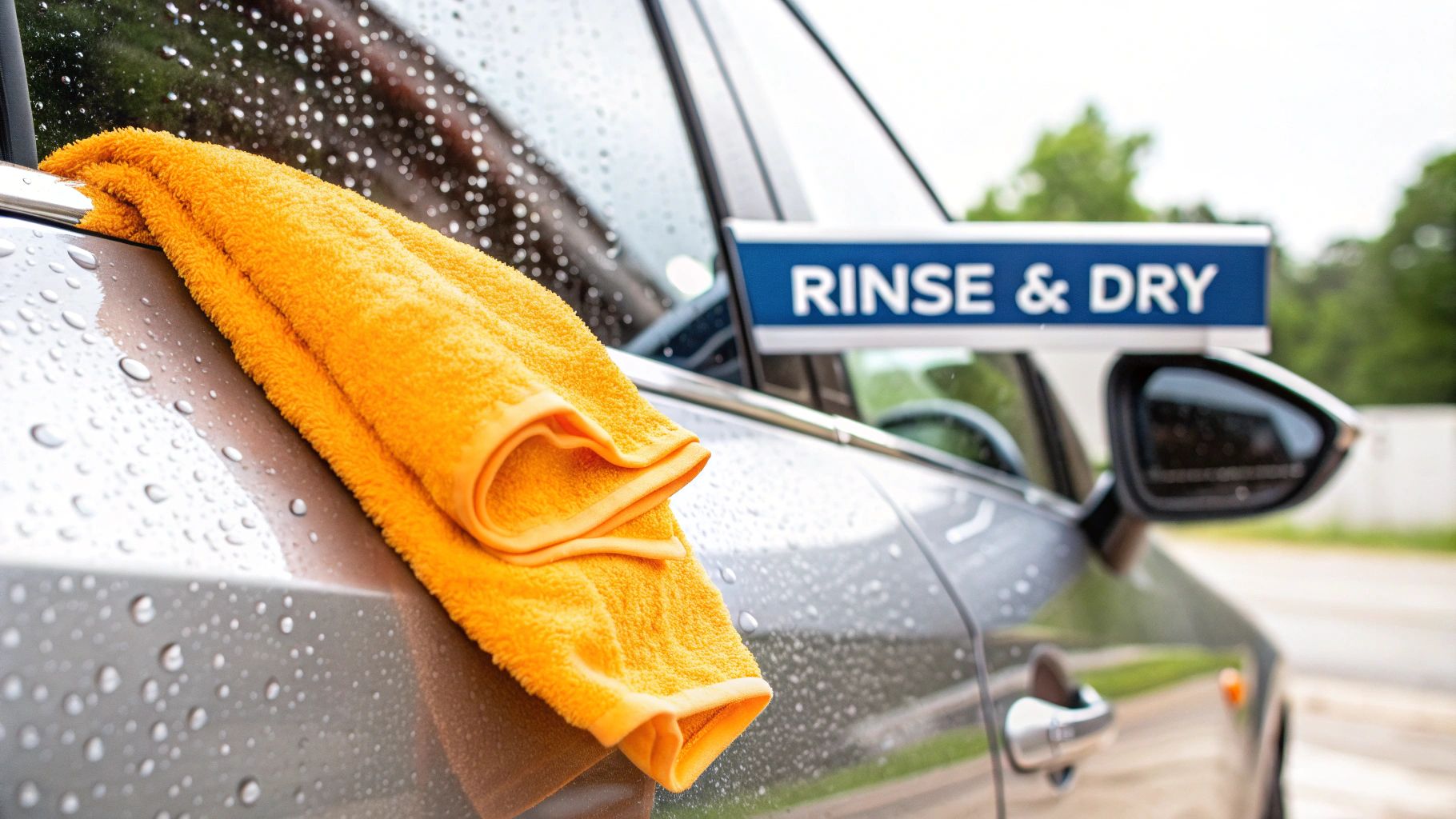Essential Supplies That Make The Difference

Achieving a professional-level car wash at home doesn't require expensive gadgets. It's about understanding which supplies truly impact cleaning power and paint protection. Let's explore the essentials that elevate your car washing game.
The Foundation: Soap, Buckets, and Mitts
The best at-home car wash starts with the basics. Using a high-quality car wash soap, designed for automotive paint, is crucial. Dish soap can strip protective waxes, leaving your car vulnerable. Think of car wax like sunscreen – you wouldn't use dish soap to remove it.
The two-bucket method is also essential. One bucket holds soapy water, the other clean rinse water. This prevents reintroducing dirt onto your car, minimizing swirl marks and scratches. It's similar to rinsing a paintbrush in clean water before dipping it back into paint. Finally, a microfiber wash mitt is gentler than a sponge, trapping dirt instead of dragging it across the paint.
Enhancing Your Wash: Wheels, Hoses, and Dryers
Wheels require special care due to brake dust and road grime. A dedicated wheel cleaner and a separate wash mitt are essential. For a pristine finish, consider a pressure washer, although a standard garden hose with a spray nozzle works well too.
Drying your car correctly is as important as washing. A high-quality microfiber drying towel quickly absorbs water, preventing water spots and minimizing scratches. It's like using a soft cloth for delicate glassware instead of a rough dish towel.
The global car wash and detailing market is booming, projected to reach $54.98 billion by 2029, with a CAGR of 5.84%. This highlights the increasing value placed on professional car care. However, washing your car at home with the right techniques and supplies can deliver equally impressive results. More detailed statistics are available here. For those interested in mastering the foam gun, check out this guide: How to master the foam gun.
Essential Vs Optional Car Washing Supplies
To help you understand the key supplies needed for a successful car wash, we've compiled a comparison table. It outlines essential items and optional upgrades for different budgets and experience levels.
| Item | Essential Level | Cost Range | Benefits | Alternatives |
|---|---|---|---|---|
| Car Wash Soap | Essential | $5 - $20 | Specifically formulated for car paint protection | Dish soap (not recommended) |
| Wash Mitt | Essential | $5 - $15 | Gentle cleaning, reduces swirl marks | Sponge (not recommended) |
| Buckets (2) | Essential | $5 - $10 | Two-bucket method prevents recontamination | Single bucket (not ideal) |
| Wheel Cleaner | Essential | $8 - $25 | Removes brake dust and road grime effectively | All-purpose cleaner |
| Drying Towel | Essential | $10 - $30 | Absorbs water quickly, prevents water spots | Old towels (not ideal) |
| Pressure Washer | Optional | $50 - $200 | Increased cleaning power and efficiency | Garden hose with spray nozzle |
| Wheel & Tire Brush | Optional | $5 - $15 | Deep cleans hard-to-reach areas on wheels | Wash mitt |
As this table demonstrates, achieving a great car wash at home doesn't have to break the bank. Prioritizing the essential items ensures a safe and effective clean.
These supplies, used correctly, provide the foundation for an effective and safe car wash at home. By focusing on quality and technique, you can achieve professional results without the professional price tag. This sets the stage for the next crucial step: water conservation.
Smart Water-Saving Techniques That Actually Work

Saving water while washing your car doesn't mean sacrificing a clean car. In fact, some of the most effective at-home car wash methods prioritize smart water usage. This involves a shift towards efficiency, adopting techniques that minimize water waste while still delivering sparkling results. Let's explore how to achieve a pristine car while conserving this precious resource.
The Power of Pre-Rinsing and the Two-Bucket Method
An effective pre-rinse is the first step in a water-wise car wash. This initial rinse loosens dirt and debris, reducing the amount of soap and water needed later. Think of it like pre-soaking dishes – it simplifies the cleaning process. This leads naturally to the two-bucket method.
This method is a cornerstone of water-saving car washing. One bucket holds soapy water, the other holds rinse water for your wash mitt. This prevents cross-contamination, reducing the overall water needed. Maintaining clean supplies is also crucial, much like the importance of cleaning your car.
Exploring Waterless Washing and Biodegradable Soaps
Beyond traditional methods, waterless washing offers a new approach to car cleaning. These specially formulated products lift and encapsulate dirt, allowing you to wipe it away without water. Choosing biodegradable soaps is also essential for environmentally conscious car owners.
Biodegradable soaps effectively clean your car while minimizing environmental impact on local water systems. This makes your car washing routine both effective and responsible. Interestingly, consumer car washing habits have changed. In 1996, 52% of consumers washed their cars at home. By 2023, this preference dropped by 60%.
A typical home car wash uses about 38 gallons of water, while professional washes can use considerably less with advanced systems. More detailed statistics can be found here.
Optimizing Your Rinse and Drying Techniques
Even with traditional methods, mindful rinsing drastically reduces water usage. Instead of a continuously running hose, use short bursts to rinse each section. This targeted approach is just as effective while conserving water. Using a high-quality microfiber drying towel also minimizes rinsing needs.
These small changes add up to substantial water savings over time. By adopting these techniques, you can reduce your environmental impact and lower your water bill, all while maintaining a spotless vehicle.
The Complete Washing Process for Showroom Results

This infographic provides a core process for washing your car at home, emphasizing the right soap mixture, the two-bucket method, and a systematic approach. Following these steps helps minimize swirl marks and ensures a consistent clean.
Achieving a showroom shine at home depends on the right process. It's not just cleaning—it's about preserving your car's paint and extending its life. A systematic approach is the best way to achieve professional results.
The Pre-Rinse: More Important Than You Think
Start by rinsing your car with water. This removes loose dirt and debris, preventing scratches during washing. It's like sweeping before mopping—preparation for a deeper clean. A pressure washer offers superior cleaning power, but a garden hose with a spray nozzle also works well.
A thorough pre-rinse sets the stage for effective cleaning. It's a simple step, but it makes a big difference in the final result.
Soap Application: The Two-Bucket Method
Next is the two-bucket method. One bucket holds your soap solution (1 oz of car wash soap per gallon of water), the other has clean rinse water. Dip your wash mitt in the soap, wash a section, then rinse the mitt in the clean water before adding more soap. This prevents dirt transfer, minimizing scratches. For additional tips, check out this article on foaming your car wash.
This method is crucial for maintaining a clean wash and protecting your car's finish. It's a small change that yields significant results.
Sectional Washing: Top-Down Approach
Wash in sections, top to bottom, to prevent streaks and ensure even cleaning. Divide your car into four sections (roof, hood and front, sides, and rear), spending about 5 minutes on each. Gravity helps, carrying dirt down as you clean.
This top-down approach ensures a consistent clean and minimizes the chance of streaks. It's a systematic method that simplifies the washing process.
Rinsing and Drying: The Final Touches
Rinse each section thoroughly with clean water after washing. This prevents soap residue and streaks. Once washed, dry immediately with a high-quality microfiber drying towel to prevent water spots and enhance shine. A drying aid can further improve the process by lubricating the surface.
By following these steps—pre-rinse, two-bucket wash, sectional cleaning, and thorough drying—you’ll master the art of washing your car at home and achieve professional-level results. This not only cleans your car but protects the paint, maintaining its value and appearance. The result is a car that looks its best and stays that way longer.
Advanced Techniques for Every Surface and Challenge

Washing a car isn't a one-size-fits-all endeavor. Different surfaces and stubborn grime require specific approaches for a truly pristine finish. This section explores advanced techniques to tackle these challenges, no matter your car's condition.
Decoding Different Paint Finishes
Modern cars often feature clear coats, a protective layer over the paint. These require gentle cleaning with a microfiber wash mitt and pH-neutral car wash soap to avoid scratches.
However, the increasingly popular matte finishes demand a completely different approach. Harsh chemicals and even some car wash soaps can damage these specialized paints.
Dedicated matte-finish cleaners and protectants are essential for preserving their unique appearance. Just like different fabrics have specific washing instructions, so do different car finishes. This specialized care ensures your cleaning enhances, rather than detracts from, your car's look.
Battling Stubborn Contaminants: Tree Sap, Bugs, and Road Salt
Beyond regular dirt, cars face tougher adversaries. Tree sap, for instance, needs a specialized sap remover to avoid damaging the clear coat. It’s similar to using a specific stain remover on clothing instead of harsh bleach.
Similarly, baked-on bug residue responds best to a dedicated bug and tar remover. These products break down the grime without harming the underlying paint.
In winter, road salt is a serious threat to your car's undercarriage. Regular undercarriage washes during the winter months are vital to prevent corrosion and rust. This proactive approach minimizes long-term damage and preserves your car's value.
Seasonal Washing Adaptations and Wheel Care
Seasonal changes require adjustments to your washing routine. In summer, washing in the shade prevents water spots from quickly drying. This small change makes a big difference in achieving a spotless result.
Winter washing necessitates a different tactic. Thoroughly rinsing the undercarriage is crucial to remove corrosive road salt. Also, consider a sealant after washing to protect the paint from harsh winter conditions.
Finally, wheels and tires need their own special attention. A dedicated wheel cleaner and tire brush are essential for removing brake dust and road grime. This targeted cleaning enhances your car's overall appearance and protects your wheels from long-term damage.
These advanced techniques, along with regular maintenance, will keep your car looking its best year-round. By understanding your car’s specific needs and adapting your approach accordingly, you can achieve professional results at home.
Creating Your Personal Maintenance Schedule
Keeping your car in top condition goes beyond just appearances. It significantly impacts its lifespan and how much it will be worth down the line. A regular maintenance schedule, tailored to your specific driving habits and the environment you drive in, is key to effectively washing your car at home. Think of it as preventative care for your vehicle.
Understanding Your Car's Needs
Start by honestly evaluating your driving conditions. Do you often find yourself on dirt roads or in areas where salt is heavily used in the winter? These factors mean you'll need to wash your car more often. Climate also plays a role. Cars exposed to harsh weather, such as extreme heat or freezing temperatures, need extra care. Just like you would adjust your skincare routine with the changing seasons, your car washing schedule needs similar attention. This proactive approach not only maintains your car's looks but also prevents damage in the long run.
Building a Personalized Schedule
The most effective way to wash your car at home involves finding a good balance: thorough cleaning to protect your investment, but also a routine that realistically fits your lifestyle. Consider the following when creating a schedule:
- Driving Frequency: The more you drive, the more dirt and grime your car collects.
- Environmental Factors: Harsh weather, including salt and extreme temperatures, requires more frequent washes.
- Storage: Cars parked outside need more frequent cleaning than those kept in a garage.
Washing your car every two weeks is a good starting point for vehicles driven regularly. However, this can be adjusted based on the factors mentioned above. If you mostly drive on paved roads in a mild climate, a monthly wash might be sufficient. Also, learn to recognize when your car needs a wash, such as noticeable dirt buildup, bug splatters, or a dull finish. This personalized approach ensures your car stays in great condition.
Balancing Frequency and Long-Term Value
Interestingly, how often people wash their cars varies quite a bit. In the U.S., retail car wash customers typically visit around three times a year, while those with subscriptions might go as often as three times a month. This highlights the importance of a personalized schedule. You can find more detailed statistics from the International Carwash Association.
Finding the right balance between washing frequency and long-term value is important. Over-washing, especially with harsh chemicals, can damage your car's paint over time. On the other hand, neglecting regular cleaning allows dirt to accumulate, which can also harm the finish. It’s like finding the right balance with exercise – enough to stay healthy, but not so much that you risk injury. A consistent washing schedule is essential, not just for keeping your car looking good, but also for preserving its value over the long term. This consistent effort contributes to a higher resale value, protecting your investment.
Drying and Protection for Lasting Shine
The final step in a DIY car wash is drying and protecting the finish. This crucial stage determines how long your hard work lasts and how well your car resists dirt and grime. Proper drying prevents those unsightly water spots and enhances the shine, making your car look its best.
Effective Drying Methods: From Chamois to Microfiber
Several different methods exist for drying your car, each with its own advantages and disadvantages. The traditional chamois cloth, made from natural leather, is highly absorbent. However, a chamois can be expensive and requires careful maintenance. Modern synthetic chamois cloths offer a more affordable and easier-to-care-for alternative, providing similar absorbency.
Microfiber drying towels are another popular and effective choice. These towels are incredibly soft and absorb water quickly, minimizing the chance of scratching your car's paint. Regular car care, much like website maintenance, demands consistent effort for the best results. For more information on banishing water spots, check out this helpful article: How to avoid water spots.
Drying Techniques: Avoiding Swirls and Spots
No matter your towel of choice, the technique you use is key. Gently drag the towel across the paint in straight lines, avoiding circular motions. This helps prevent swirl marks. Begin at the top of the car and work downwards, letting gravity assist you. If your car is especially dirty, use multiple towels to prevent reintroducing dirt onto the clean paint. This careful approach will ensure a spotless and swirl-free finish.
Protection: Wax and Sealants for Long-Lasting Shine
Protecting your car’s paint after drying is the next essential step. Car wax creates a deep shine and protects against the elements. Sealants, conversely, offer more durable protection, but they may not produce the same glossy shine as wax. The best choice between wax and sealant depends on your priorities and how often you want to reapply the product.
Maintenance Between Washes: Quick Detailers and Waterless Washes
Keeping your car gleaming between washes is easy with the right products. Quick detailers are spray-on solutions that remove light dust and fingerprints, restoring shine without a full wash. For heavier dirt, consider a waterless wash. These products encapsulate dirt, allowing you to safely wipe it away without scratching.
To help you select the ideal drying method, take a look at the following comparison:
Drying Methods Comparison Analysis of different car drying techniques showing effectiveness, time required, and potential risks to paint.
| Method | Effectiveness | Time Required | Paint Safety | Best Use Case |
|---|---|---|---|---|
| Chamois (Natural) | High | Moderate | Moderate | Enthusiasts, Show Cars |
| Chamois (Synthetic) | High | Moderate | High | Regular Washing |
| Microfiber Drying Towel | Excellent | Fast | Excellent | All Purposes |
This table summarizes the pros and cons of each drying method, highlighting microfiber as the most efficient and safest option for general use, while natural chamois caters to a more specialized approach.
By selecting the right drying and protection products and maintaining your car regularly, you can preserve that showroom shine for weeks. This not only enhances your car’s appearance but also protects its paint, helping maintain its value over the long term.
Key Takeaways
Washing your car at home can be more than just a routine chore; it's an opportunity to protect your investment and maintain its value. By understanding the most effective car washing techniques, you can achieve professional results while saving money and conserving water. This guide offers practical advice, distilled from professional detailers and real-world testing, to help you master the art of the home car wash.
Essential Equipment and Supplies
The foundation of a successful car wash lies in having the right tools. This doesn't necessarily mean investing in expensive gadgets, but rather selecting supplies that truly make a difference.
- Car Wash Soap: Opt for a dedicated car wash soap instead of dish soap, which can strip away protective waxes.
- Two-Bucket Method: Employing two separate buckets—one for wash water and the other for rinsing—is crucial to prevent scratches and swirl marks.
- Microfiber: From wash mitts to drying towels, microfiber materials are essential for gentle cleaning and minimizing the risk of damage.
The Washing Process: A Step-by-Step Guide
The most effective way to wash your car at home involves a systematic approach that ensures thorough cleaning and protects your car's paint. Here’s a recap of the key steps:
- Pre-Rinse: Start by thoroughly rinsing the car to remove loose dirt and debris before applying soap.
- Soap Application (Two-Bucket Method): Using a microfiber wash mitt and the two-bucket method, apply the car wash soap, working from the top of the car down.
- Sectional Washing: Wash the car in sections to prevent streaks and ensure complete coverage.
- Rinse: Thoroughly rinse each section after washing to remove all soap residue.
- Dry: Dry the car immediately with a high-quality microfiber drying towel to prevent water spots.
Advanced Techniques for Challenging Situations
Different cars and seasons may require specific approaches to washing:
- Paint Types: Consider your car's paint type. Matte finishes, for instance, often require specialized care.
- Stubborn Contaminants: For removing stubborn contaminants like tree sap, bug residue, and road salt, consider using dedicated cleaning products.
- Seasonal Adjustments: Adapt your car washing routine to the weather. In winter, undercarriage washing is vital for preventing rust caused by road salt.
Creating Your Maintenance Schedule
Consistency is key to preserving your car's appearance and value. A personalized maintenance schedule should take into account your driving habits, the environment, and your car type.
- Assessment: Evaluate your driving conditions and how frequently your car is exposed to dirt, salt, or inclement weather.
- Frequency: A good starting point is a bi-weekly wash, but adjust this frequency based on your assessment.
- Long-Term Value: Regular maintenance not only keeps your car looking its best but also helps protect its resale value.
Drying and Protection: The Finishing Touches
Proper drying and protection are essential for enhancing shine and extending the life of your car wash:
- Drying Methods: Microfiber drying towels are generally the safest and most effective drying method.
- Protection: Consider applying wax or sealant to add an extra layer of protection to your car’s paint and maintain its shine.
- Maintenance Between Washes: Quick detailers and waterless washes can help maintain your car’s cleanliness between full washes.
By incorporating these key takeaways, you can transform car washing from a mundane chore into a satisfying way to maintain and protect your vehicle.
Ready to take your car washing to the next level? The SwiftJet Car Wash Foam Gun, with its powerful foam action, lifts dirt and grime, simplifying the washing process and delivering a professional-grade clean. Get your SwiftJet Foam Gun today!
